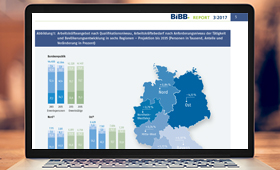Boom in the south, slump in the east
Stark contrasts in the development of regional labour markets
42/2017 | Bonn, 23.11.2017

There will be a marked difference in the development of regional labour markets in Germany up to 2035. The reasons for this are different economic priorities in the regions and demographic changes. Evidence for this is provided by the latest regional-specific findings of the Qualifications and occupational field projections from the Federal Institute for Vocational Education and Training (BIBB) and from the Institute for Employment Research (IAB). These are published in the most recent issue of the “BIBB REPORT” series.
While Bavaria and Baden-Württemberg will also benefit in future from a high level of inward migration by job seekers and, consequently, from a younger and growing population, eastern Germany can continue to expect a declining and ageing population. Nationwide recruitment difficulties evident to date in the “health occupations” and in “technical occupations”, such as in energy technology or electrical engineering, will not turn out to be quite as pronounced as predicted some years ago in eastern and southern Germany due to increased efforts made in the past in the area of training. By contrast, long-term shortages are emerging nationwide in the “construction occupations” as well as in the occupations of “construction, woodworking, plastics manufacture and processing”. In these areas, the supply of labour will fall primarily due to demographic changes.
The model calculations of the BIBB and the IAB form the basis of the expected developments up to 2035 in six regions of Germany: North Rhine-Westphalia, Bavaria, Baden-Württemberg, Region North (Hamburg, Bremen, Lower Saxony and Schleswig-Holstein), Region Mid-West (Hessen, Rhineland-Palatinate, Saarland) and Region East (Berlin, Brandenburg, Mecklenburg-West Pomerania, Saxony, Saxony-Anhalt and Thuringia).
In the heavily industrialised regions such as Bavaria, Baden-Württemberg and North Rhine-Westphalia, evidence of increased growth in company-related services is likely to lead to further growth in employment. In North Rhine-Westphalia, this trend will be accompanied by a simultaneous reduction in heavy industry.
The strengths of the northern region lie in agriculture and forestry, the fishing industry, vehicle manufacturing and logistics. However, future changes in demand structures point to shortages to come. For example, there is a long-term increase in demand for skilled workers in agriculture (raw material extraction occupations). Labour supply however is not keeping pace with this development. In the mid-west region, the economy is focused increasingly on the finance and insurance sector in addition to the areas of transport and logistics. From as early as 2020 onwards, the health sector in eastern Germany will be the largest sector and this region will therefore be focussed on personal services to an even greater extent than before.
The qualifications and occupational field projections (QuBe Project) which are conducted in conjunction with the Institute of Economic Structural Research (GWS) and the Fraunhofer Institute for Applied Information Technology (FIT), use model calculations as a basis for showing how the supply of and demand for qualifications and occupations may develop on a long-term basis up to 2035.
Further information is available in the new issue of BIBB REPORT, issue 3/2017: “Occupational labour market characterised by regional differences”. The issue can be downloaded free of charge at www.bibb.de/bibbreport (available in German only).
All findings at the level of occupations, qualifications and requirements can also be accessed by region via the QuBe data portal at www.QuBe-Data.de (in German only).
Specimen copy requested if printed.